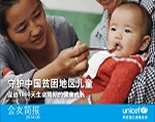 © UNICEF/China/2009 © UNICEF/China/2009
Launch event of the SOWC report 2009. |
BEIJING, 12 March 2009 – Women in the world's least developed countries are 300 times more likely to die in childbirth or from pregnancy-related complications than women in developed countries, according to UNICEF's latest State of the World's Children (SOWC) report. In China around 7,000 women die in childbirth each year, down 59 per cent from 1990 levels, but still representing 1.3 per cent of the world's maternal deaths.
UNICEF's SOWC report for 2009, the 30th anniversary of its renewed programme for children in China, focuses on maternal and newborn health – key indicators of progress toward the Millennium Development Goals for 2015. Early newborn death, or neonatal mortality, tops the list of preventable causes of child death in China at 60 per cent. The main causes of neonatal mortality (death in the first four weeks of life) are asphyxia (due to lack of oxygen before delivery), low birth weight and infection. Many of these deaths can easily be prevented.
"Whilst China has made great progress in maternal and child health in recent years, this report highlights that further gains can be made in reducing maternal and newborn mortality in China," said Dr. Yin Yin Nwe, UNICEF Representative to China. "In rural areas almost 1.6 times as many mothers die in childbirth as in urban centres, and neonatal mortality still accounted for a staggering 229,200 child deaths in 2007."
This year the launch of UNICEF's "flagship" publication will in part recognize the 30th Anniversary of UNICEF's renewed programme of cooperation for children in China. In 1979 UNICEF was invited to return to China and begin assessments that would eventually lead to the full re-establishment of its programme activities with the Government of China in 1981.
Overall, China has achieved significant reductions in rates of maternal, child and infant mortality over the last two decades. However, absolute numbers remain very high - indeed, according to the SOWC 2009 China has the fifth highest number of child deaths per year in the world, with an estimated 382,000 children dying before their fifth birthday in 2007. Maternal and child death rates in China are at intermediate level by global standards, still far higher than rates in developed countries and also higher than some countries less economically developed than China.
A key concern for maternal and newborn health in China is the large disparity between coastal and urban areas and remote rural communities. Infant and child mortality is almost 2.7 times higher in the western than eastern regions, 2.4 times higher in rural than urban areas, and 2 to 5 times higher in the poorest rural counties than in large cities.
The Report suggests that continued progress on reducing infant and maternal mortality will require additional efforts to ensure that all women have access to quality obstetrical services, especially in hard-to-reach parts of the country. Improved care for women before, during and after pregnancy is also a cost-effective way of enhancing young child health and nutrition. In addition, it draws attention to the importance of care for newborn babies, with an emphasis on early and exclusive breastfeeding, keeping the newborn warm and the routine conduct of simple but careful postnatal check-ups, at least twice within the first seven days after birth.
The 2006 Joint Review of China's Maternal and Child Survival Strategy by the Ministry of Health, with support from UNICEF, the World Health Organization and the UN Population Fund supports the current report's main conclusions on key interventions. Many of China's remaining preventable young child deaths occur in poor, remote areas where access to and uptake of quality services are lacking. In addition, advanced health services are often unaffordable for poor rural families, and also many migrants in urban areas. The maternal and child health gains China has made since 1990 have been achieved through heavy investment in public health infrastructure, and more recently insurance and financing schemes to increase access and demand. In the last two decades hospital delivery rate has increased in China from 51% to 92%. By 2007, the hospital delivery rate stood at 96% in urban areas and 89% in rural areas. However, as the Joint Review notes, significant challenges remain.
About UNICEF in China:
UNICEF first assisted China between 1947 and 1951, providing emergency services, food and nutrition, health and hygiene training during and after the war of liberation. In 1979 UNICEF recommenced its cooperation with the Government of China which today supports child health and nutrition, clean water and sanitation, quality basic education for all boys and girls, and the protection of children from violence, exploitation, and AIDS. UNICEF is on the ground in over 150 countries and territories to help children survive and thrive, from early childhood through adolescence.
For further information, please contact:
Dale Rutstein, UNICEF China, +86 13910973801, drutstein@unicef.org
Liu Li, UNICEF China, +86 13701066671, liliu@unicef.org





























